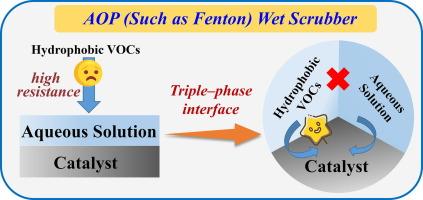Bypassing gas-liquid mass transfer resistance in a Fenton wet scrubber for boosting the removal of hydrophobic styrene: Construction of a novel gas-solid-liquid triple-phase interface
IF 13.3
1区 工程技术
Q1 ENGINEERING, CHEMICAL
引用次数: 0
Abstract
Advanced oxidation processes (AOPs, such as Fenton) coupled with wet scrubbers are powerful and eco–friendly for VOCs treatment. However, challenges remain in the efficient removal of hydrophobic VOCs due to the extremely high gas-liquid mass transfer resistance. Herein, we constructed a “gas-solid-liquid triple-phase interface” in a Fenton wet scrubber via fabricating a new amphiphilic catalyst (PAN@Fe3O4@Nafion), which allows to capture gas bubbles and directly convey the VOCs to catalytic active center through gas transport and bypass the gas-liquid mass transfer (rate–determining) step. Compared with system with the unmodulated catalyst, the removal efficiency of hydrophobic styrene in the triple-phase interface Fenton wet scrubber was improved by 69.0%, the intermediates were dominated by small–molecule fatty acids (98.0%), and the outlet CO2 concentration and H2O2 consumption increased by 22.1% and 19.6%, respectively. Notably, mechanism analysis via confocal laser scanning microscopy and contact angle measurements revealed the arrangement of hydrophilic and hydrophobic regions on the catalyst surface. Moreover, the affinity ability of bubbles was 2.5 times greater and the mass transfer enhancement factor reached 2.2 in the triple-phase interface Fenton wet scrubber system. This study provides a new avenue for overcoming the gas-liquid mass transfer resistance of hydrophobic VOCs in AOP wet scrubbers.

求助全文
约1分钟内获得全文
求助全文
来源期刊

Chemical Engineering Journal
工程技术-工程:化工
CiteScore
21.70
自引率
9.30%
发文量
6781
审稿时长
2.4 months
期刊介绍:
The Chemical Engineering Journal is an international research journal that invites contributions of original and novel fundamental research. It aims to provide an international platform for presenting original fundamental research, interpretative reviews, and discussions on new developments in chemical engineering. The journal welcomes papers that describe novel theory and its practical application, as well as those that demonstrate the transfer of techniques from other disciplines. It also welcomes reports on carefully conducted experimental work that is soundly interpreted. The main focus of the journal is on original and rigorous research results that have broad significance. The Catalysis section within the Chemical Engineering Journal focuses specifically on Experimental and Theoretical studies in the fields of heterogeneous catalysis, molecular catalysis, and biocatalysis. These studies have industrial impact on various sectors such as chemicals, energy, materials, foods, healthcare, and environmental protection.
 求助内容:
求助内容: 应助结果提醒方式:
应助结果提醒方式:


